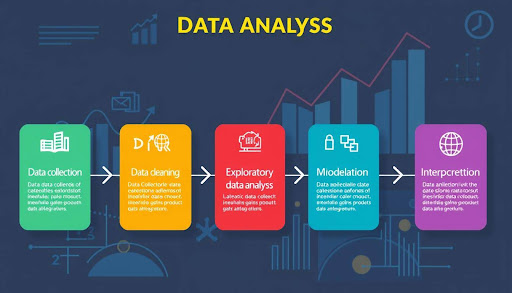| Imperium Dynamics
Did you know businesses that use data well are 5% more productive and 6% more profitable? This shows how important data analysis is today.

Anyone who wants to use data effectively must know the stages of data analysis. By learning the process, you can turn numbers into valuable insights. This guide will help you understand the stages of data analysis, preparing you to work with data confidently.
Key Takeaways
- Businesses using data effectively are more productive and profitable.
- Understanding the stages of data analysis is essential for transforming raw data into actionable insights.
- This guide covers the fundamental stages of the data analysis process.
- Mastering each stage can lead to more informed decision-making.
- Knowledge of the data analytics lifecycle is key to business success.
Introduction to Data Analysis
Data analysis is key to finding useful information in data. It involves checking, cleaning, changing, and modeling data. This helps us draw conclusions and make better decisions.
What is Data Analysis?
Data analysis uses statistics and logic to understand data. It includes steps like collecting, cleaning, and making models, which help turn raw data into useful insights.
Importance of Data Analysis in Decision Making
Data analysis is vital in today's world. It helps make informed decisions, not guesses. Analyzing data allows us to spot trends and patterns, leading to better choices and results.
Applications of Data Analysis in Various Industries
Data analysis is helpful in many fields, including
healthcare and finance. In healthcare, it predicts
patient outcomes. Finance uses it to check for risk and
fraud. Marketing uses it to understand customers.
Every industry benefits from data analysis. It drives
innovation and efficiency. The careful processing of
data leads to better insights.
| Industry | Application | Benefit |
|---|---|---|
| Healthcare | Predictive Analytics | Improved Patient Outcomes |
| Finance | Risk Management | Fraud Detection |
| Marketing | Consumer Insights | Optimized Campaigns |
The Different Phases of Data Analysis
Data analysis is key to turning raw data into useful insights. Whether you're new or experienced, knowing the steps helps your work. It makes your efforts more effective.
Data Collection
The first step is collecting data. This means getting the correct data from different sources, which is important for the quality and relevance of your study.
Data Cleaning and Preparation
After collecting data, it must be cleaned and prepared. This step fixes errors, removes duplicates, and prepares the data for analysis. Good data cleaning ensures the reliability of the data.
Exploratory Data Analysis (EDA)
Exploratory Data Analysis (EDA) is critical. It looks for patterns, relationships, and outliers in the data. This phase gives you a first look at what the data might say.
Data Modeling
Data modeling uses statistical models or machine learning to predict or classify data. It's essential for forecasting trends and making decisions. It gives a solid base for making choices based on data.
Data Interpretation
The last step is interpreting the data. Here, you make
sense of the results from the modeling phase. Accurate
interpretation helps organizations make smart decisions.
It improves strategies and operations.
Knowing these data analysis phases can greatly enhance
your projects. Each step is connected and essential for
getting accurate insights.
Tools and Techniques for Data Analysis
In today's world, the right tools and techniques are key to quickly gaining valuable insights. Many tools have been created to help analysts do their jobs better, from simple stats to complex machine learning. Knowing these tools is important, as they make tasks like collecting, cleaning, and interpreting data easier.
- Excel is simple and powerful, making it great for basic tasks. It also has features like pivot tables and data visualization tools.
- R: An open-source tool for statistics and graphics, R's huge package library makes it suitable for complex tasks.
- Python: It's easy to read and flexible. Libraries like Pandas and Matplotlib are perfect for data work.
- SQL is key to working with databases. It helps access, update, and manage data in relational systems.
- Tableau: This tool makes complex data easy to understand. It offers interactive dashboards for sharing insights.
There are also advanced tools for machine learning and predictive analytics:
- SAS: It's known for its strong analytics. SAS offers tools for advanced analysis and business intelligence.
- Apache Hadoop: It's a framework for big data. Hadoop helps manage and analyze large datasets.
- MATLAB: Used in academia and industry, MATLAB is great for numerical computing and has many functions for data work.
These tools and methods are just a few available to analysts. The choice of data analysis methodology and tools depends on the analysis's needs. Here's a quick guide to their main uses:
| Tool | Primary Use | Industry Use |
|---|---|---|
| Excel | Descriptive statistics, basic visualization | Finance, Marketing |
| R | Statistical computing, data visualization | Research, Bioinformatics |
| Python | Data manipulation, machine learning | Technology, Data Science |
| SQL | Data querying, database management | All sectors |
| Tableau | Interactive data visualization | Business Intelligence |
| SAS | Advanced analytics, business intelligence | Clinical Trials, Banking |
| Apache Hadoop | Big data processing | E-commerce, Healthcare |
| MATLAB | Numerical computing, algorithm development | Engineering, Academia |
Using these tools lets organizations get the most out of their data. This gives them the insights they need to make smart decisions.
The stage of data analysis: Data Collection to Interpretation
From collecting data to interpreting it, each step is vital. They ensure we get accurate and useful insights. Let's explore the process, highlighting the importance of each phase.
Data Collection Techniques
Data collection starts with methods like surveys,
interviews, and web scraping. These gather raw data from
various sources. Surveys reach out to people online,
while web scraping pulls data from websites for market
research.
It's key to use a wide range of data collection methods.
This makes analysis stronger and more reliable.
Cleaning and Preparing Data
After gathering data, we clean and prepare it. This step
removes errors and prepares the data for use. Cleaning
ensures that the data is accurate and free of
duplicates.
Tools like software help in this process. They improve
the quality and reliability of our analysis.
Using Microsoft Power BI for Data Visualization
Once the data is ready, we visualize it. Microsoft Power
BI is a top tool for creating interactive dashboards. It
turns complex data into easy-to-understand visuals.
This helps everyone see trends and patterns quickly. It
makes decision-making easier and faster.
Best Practices in Data Interpretation
The final step is to interpret the data. It's important
to be accurate, objective, and clear. This ensures that
our conclusions are valid.
Being objective reduces bias. Clear communication helps
everyone understand the data's meaning. These practices
make our analysis trustworthy and effective.
| Phase | Key Techniques | Main Tools |
|---|---|---|
| Data Collection | Surveys, Interviews, Web Scraping | SurveyMonkey, Scrapy |
| Data Cleaning | Removing Inconsistencies, Correcting Errors | OpenRefine, Python Pandas |
| Data Visualization | Interactive Dashboards, Visual Reports | Microsoft Power BI |
| Data Interpretation | Accuracy, Objectivity, Clarity | N/A (Best Practices) |
Conclusion
This guide shows how important a step-by-step approach
to data analysis is. Each stage, from gathering data to
interpreting it, is key. It ensures the analysis is
reliable and useful.
By following the best ways to collect, clean, and
visualize data, we prepare for deep analysis. Tools like
Microsoft Power BI help us see our data
clearly.
This guide reminds us that each step in data analysis
depends on the others. Starting with accurate data
collection is vital. Then, cleaning, exploring,
modeling, and interpreting the data follow, each one
building on the last. Together, these steps help us get
insights that lead to better decisions in many fields.
They show how important it is to do each step well. As
we finish, it's key for experts to use these methods in
their work. This makes their findings more reliable and
useful. Understanding the value of each step helps us do
our data analysis better.
By being thorough and careful in our data analysis, we
get results that really matter. This approach helps us
make a big impact with our data.
FAQ
What are the stages of data analysis?
Data analysis has several stages. First, you collect the data. Then, you clean and prepare it. Next, you do Exploratory Data Analysis (EDA). After that, you model the data. Lastly, you interpret the findings.
Why is data analysis important in decision making?
Data analysis turns raw data into useful insights. This helps businesses make smart choices based on facts, reduce uncertainty, and find new growth opportunities.
What are some common applications of data analysis in various industries?
Data analysis is used in many fields. In healthcare, it manages patient data. In finance, it assesses risks. Marketing uses it for customer segments, and retail optimizes inventory. It boosts performance and predicts trends
What techniques are included in the data analysis methodology?
The methodology uses many techniques. You have descriptive and inferential statistics. Machine learning and data mining are also used. Each method answers specific questions or solves problems.
How many steps are there in the data analysis process?
The process has five main steps. First, you define your objectives. Then, you collect the data. Next, you clean and prepare it. After that, you analyze it. Lastly, you interpret and report the findings.
Can you explain the data analysis lifecycle?
The data analytics lifecycle is a structured way to analyze data. It starts with understanding business needs. Then, you prepare, model, evaluate, and deploy the data. It ensures reliable insights through each step.
What are some effective data collection techniques?
Effective techniques include surveys and interviews, web scraping, sensor data collection, transactional data extraction, and APIs. Each is chosen based on the data needed
Why is data cleaning and preparation so important?
Cleaning and preparing data is key. It removes errors and handles missing values, making the data usable and reliable for analysis.
What is Exploratory Data Analysis (EDA)?
EDA is a way to analyze data sets. It summarizes data using visual methods. Data visualization helps find patterns and anomalies and test hypotheses.
How can Microsoft Power BI be used for data visualization?
Microsoft Power BI is great for interactive visualizations. It imports data, performs queries, and presents findings, making data easier to understand through customizable dashboards.
What are the best practices in data interpretation?
Best practices include being objective and using the right statistical methods. Validate findings and communicate insights. Consider the data's context to understand it accurately.

